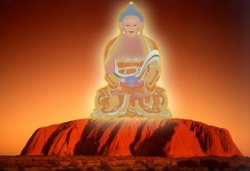Difference between revisions of "When did Buddhism come to Australia?"
m (Text replacement - "Christianity" to "{{Wiki|Christianity}}") |
|||
| Line 1: | Line 1: | ||
[[File:Uluru1.jpg|thumb|250px|]] | [[File:Uluru1.jpg|thumb|250px|]] | ||
| − | It is not known when Buddhism first came to Australia but it is likely that there was contact between the early Hindhu-Buddhist civilisations of Indonesia and the Aboriginal people of northern Australia. It is also possible that ships from the exploration fleets of the Chinese Ming emperors which landed on islands to the north of Arnhem Land may have reached the mainland of Australia between 1405 and 1433. | + | It is not known when [[Buddhism]] first came to [[Australia]] but it is likely that there was [[contact]] between the early Hindhu-Buddhist civilisations of {{Wiki|Indonesia}} and the Aboriginal [[people]] of northern [[Australia]]. It is also possible that ships from the exploration fleets of the {{Wiki|Chinese}} Ming emperors which landed on islands to the {{Wiki|north}} of Arnhem Land may have reached the mainland of [[Australia]] between 1405 and 1433. |
| − | From 1848 Chinese labourers arrived to work on the Victorian goldfields, some of whom had Buddhist beliefs but most of whom eventually returned to China. The first permanent Buddhist community was established in the 1870s by Sinhalese migrants from Sri Lanka who came to work on Queensland sugar plantations and in the Thursday Island pearling industry. By the 1890s the Thursday Island community was about 500 strong, a temple was built, festivals were celebrated and a monk was said to have visited to officiate. There were also mainly Japanese Shinto Buddhist communities in Broome and Darwin. | + | From 1848 {{Wiki|Chinese}} labourers arrived to work on the Victorian goldfields, some of whom had [[Buddhist]] [[beliefs]] but most of whom eventually returned to [[China]]. The first [[permanent]] [[Buddhist]] community was established in the 1870s by {{Wiki|Sinhalese}} migrants from [[Sri Lanka]] who came to work on Queensland sugar plantations and in the Thursday Island pearling industry. By the 1890s the Thursday Island community was about 500 strong, a [[temple]] was built, festivals were celebrated and a [[monk]] was said to have visited to officiate. There were also mainly [[Japanese]] [[Shinto]] [[Buddhist]] communities in Broome and Darwin. |
| − | Around the same time there was a wider interest in Buddhism and in 1891 Colonel Henry Scott Olcott, the co-founder of the Theosophical Society, spent several months lecturing throughout Australia on "Theosophy and Buddhism". From Federation in 1901 until the 1960s the number of Buddhists in Australia remained small but significant with the establishment of various societies and centres, and visits from overseas monks and nuns. However with increased migration from Asian countries from the 1970s Buddhism is now Australia's second largest religion after {{Wiki|Christianity}}. All three of the main traditions of Buddhism are represented in Australia and Australians have the opportunity to follow any or all, unlike people from traditional Buddhist countries who generally follow only one. | + | Around the same [[time]] there was a wider [[interest]] in [[Buddhism]] and in 1891 Colonel Henry Scott Olcott, the co-founder of the {{Wiki|Theosophical Society}}, spent several months lecturing throughout [[Australia]] on "[[Theosophy]] and [[Buddhism]]". From Federation in 1901 until the 1960s the number of [[Buddhists]] in [[Australia]] remained small but significant with the establishment of various {{Wiki|societies}} and centres, and visits from overseas [[monks and nuns]]. However with increased migration from Asian countries from the 1970s [[Buddhism]] is now Australia's second largest [[religion]] after {{Wiki|Christianity}}. All three of the main [[traditions]] of [[Buddhism]] are represented in [[Australia]] and [[Australians]] have the opportunity to follow any or all, unlike [[people]] from [[traditional]] [[Buddhist]] countries who generally follow only one. |
{{R}} | {{R}} | ||
Latest revision as of 06:43, 17 September 2013
It is not known when Buddhism first came to Australia but it is likely that there was contact between the early Hindhu-Buddhist civilisations of Indonesia and the Aboriginal people of northern Australia. It is also possible that ships from the exploration fleets of the Chinese Ming emperors which landed on islands to the north of Arnhem Land may have reached the mainland of Australia between 1405 and 1433.
From 1848 Chinese labourers arrived to work on the Victorian goldfields, some of whom had Buddhist beliefs but most of whom eventually returned to China. The first permanent Buddhist community was established in the 1870s by Sinhalese migrants from Sri Lanka who came to work on Queensland sugar plantations and in the Thursday Island pearling industry. By the 1890s the Thursday Island community was about 500 strong, a temple was built, festivals were celebrated and a monk was said to have visited to officiate. There were also mainly Japanese Shinto Buddhist communities in Broome and Darwin.
Around the same time there was a wider interest in Buddhism and in 1891 Colonel Henry Scott Olcott, the co-founder of the Theosophical Society, spent several months lecturing throughout Australia on "Theosophy and Buddhism". From Federation in 1901 until the 1960s the number of Buddhists in Australia remained small but significant with the establishment of various societies and centres, and visits from overseas monks and nuns. However with increased migration from Asian countries from the 1970s Buddhism is now Australia's second largest religion after Christianity. All three of the main traditions of Buddhism are represented in Australia and Australians have the opportunity to follow any or all, unlike people from traditional Buddhist countries who generally follow only one.
